The customer’s Volvo has an oil leak. You think you do everything right. You add dye and see the rear main oil seal leaking. The repair goes smoothly, the customer is happy…for about two weeks. Then the rear main oil seal is leaking again, and he wants to know why.
This is not an isolated case. Saab has released several TSBs on upgrading its crankcase ventilation system. It was inadequate and the excess pressure caused oil leaks. VW and Audi recommend replacing the 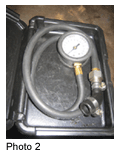 suction pump on some of its cars before leaks are repaired. Again, excess crankcase pressure can cause leaks. Repair an oil leak without eliminating the pressure, and the leak will surely return. We learned the hard way.
suction pump on some of its cars before leaks are repaired. Again, excess crankcase pressure can cause leaks. Repair an oil leak without eliminating the pressure, and the leak will surely return. We learned the hard way.
In the hope of saving you from the same aggravation, I’ll discuss some of the symptoms of a clogged oil trap; how to test crankcase pressure; and, if it’s necessary, the steps involved in replacing the oil trap and related hoses. The older Volvo 240 and 740 models and the newer s70 and s80 models had 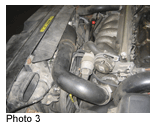 similar setups to the 850 model that I’ll be discussing in this article.
similar setups to the 850 model that I’ll be discussing in this article.
Finding the Problem:
A customer’s 850 turbo comes in and it looks like oil is leaking from just about everywhere, or the dipstick is popped out. (See Photo 1.) Both are signs of a severely plugged oil trap. If you’re doing routine maintenance and, while cleaning the throttle housing, you notice oil in the 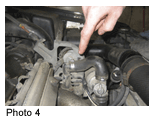 housing, there is a good chance the oil trap is plugged. This is one of the reasons for all the electronic throttle housing failures on 1999 and later Volvos. We’ve also seen uneven idles and check engine lights with fuel trim codes stored, caused by plugged crankcase ventilation systems. Other cars with minor oil leaks may have partially clogged breather assemblies and are much more difficult to diagnose.
housing, there is a good chance the oil trap is plugged. This is one of the reasons for all the electronic throttle housing failures on 1999 and later Volvos. We’ve also seen uneven idles and check engine lights with fuel trim codes stored, caused by plugged crankcase ventilation systems. Other cars with minor oil leaks may have partially clogged breather assemblies and are much more difficult to diagnose.
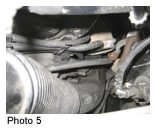 Volvo has a couple of TSBs on diagnosing and cleaning some of the crankcase ventilation systems on newer s60, s70 and s80 cars. Its special tool, P/N 9997226, is attached to the dipstick tube and at idle they want to see -0.2 KPA or less. We use an exhaust backpressure gauge with a hose attached to measure crankcase pressure (See Photo 2.) On a good car, even when raising the idle, the gauge won’t move above 0 psi. Plugged boxes are easy to see. We’ve seen more than 4 psi on some
Volvo has a couple of TSBs on diagnosing and cleaning some of the crankcase ventilation systems on newer s60, s70 and s80 cars. Its special tool, P/N 9997226, is attached to the dipstick tube and at idle they want to see -0.2 KPA or less. We use an exhaust backpressure gauge with a hose attached to measure crankcase pressure (See Photo 2.) On a good car, even when raising the idle, the gauge won’t move above 0 psi. Plugged boxes are easy to see. We’ve seen more than 4 psi on some 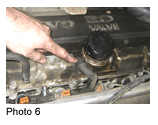 cars, and a psi of 0.5 on others. Remember that even if we see no pressure, the box can be partially plugged and should be replaced. If the car has 100,000 miles on the odometer, the oil trap should be serviced. Ignoring the problem can lead to a plugged passage leading into the oil pan, which requires oil pan removal.
cars, and a psi of 0.5 on others. Remember that even if we see no pressure, the box can be partially plugged and should be replaced. If the car has 100,000 miles on the odometer, the oil trap should be serviced. Ignoring the problem can lead to a plugged passage leading into the oil pan, which requires oil pan removal.
Replacing the Oil Trap:
So, we’ve determined that before any oil seals are replaced, we need to check and replace the oil trap. Let’s get started.
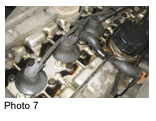 Note: Always disconnect the negative battery terminal before starting any major repair.
Note: Always disconnect the negative battery terminal before starting any major repair.
The oil trap is located under the intake manifold, so the intake needs to be removed. Photo 1 also shows the intake oil leaks around the top of the engine.
Disconnect the throttle cable (See Photo 3) and the hoses from the vacuum tree (See Photo 4) and intake housing. There were five vacuum hoses on our turbo model.
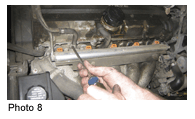
Remove the lower hose from the IAC valve, then remove the turbo intercooler to throttle housing tube. Be sure to check and clean all the vacuum ports on the tree and at the other ends of the hoses where they go into the turbo duct by the turbo (See Photo 5). The hoses will also become clogged over time.
The spark plug cover must be removed to access the hose that comes from the oil trap (See Photo 6). Oil all over the cam cover is a good indication that the oil fill cap gasket is leaking. This is also an indicator that the oil trap is plugged. (See Photo 7).


